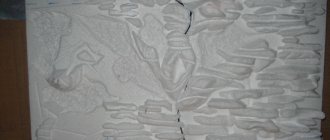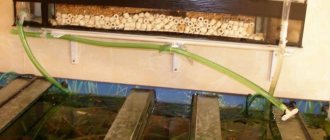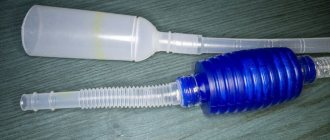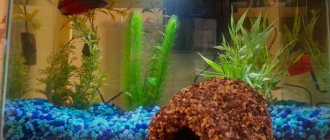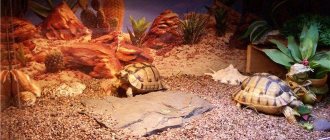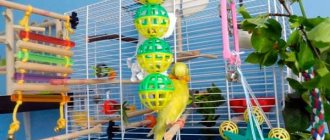Plants
The aquarium world consists not only of fish, but also of vegetation that needs regular care. One of the stages of caring for aquatic flora is the creation of a nutrient medium using fertilizing. You can purchase fertilizers for aquarium plants in a specialized store.
But inexperienced aquarists are often confused when they see the large assortment of nutritional mixtures offered. Therefore, you must first become familiar with the features of fertilizing for aquatic vegetation. And having gained some experience, it will be possible to prepare the drug at home.
Why fertilize your aquarium?
The vital activity of vegetation in an aquarium differs significantly from the “land” flora. An artificial reservoir is a complex ecosystem in which the cycle of nutrients occurs:
- excretion of excrement and carbon dioxide by fish;
- recycling of excrement by microflora living in the soil;
- delivery of mineralized organic matter and an additional portion of carbon dioxide to the root system of plants;
- absorption by plants of substances produced by microflora.
Thanks to this, green spaces receive organic fertilizers, which at first are quite enough to nourish the plants.
But as the green mass increases, a deficiency of nutrients occurs, which leads to slower growth and a change in the color of the algae. For the full growth of aquatic flora, a sufficient amount of micro- and macroelements is necessary. The lack of these substances can be judged by the appearance of the plant.
The lack of various nutrients in aquarium plants is manifested in external signs.
Signs of nutritional deficiencies are presented in the table:
| Name of substances | Symptoms of malnutrition | |
| Macronutrients | Nitrogen | Pale foliage and yellowing on stems |
| Phosphorus | The appearance of brown spots on the leaves | |
| Potassium | Slowing the growth of young foliage and the appearance of holes in it | |
| Microelements | Iron | Yellowing of leaf plates |
| Magnesium | Growth slowdown | |
| Manganese | A gradual change in color, starting from the edge and moving to the center of the leaf blades, leading to the death of leaves | |
| Calcium | Reduction in leaf size, loss of color | |
You can improve the appearance of plants using fertilizers. In addition, additional feeding is necessary when equipping the aquarium with a device that supplies carbon dioxide to the water. The plants will acquire a rich color, lethargy will disappear, and the leaves will become much fleshier. This will update the aquarium and give it a more colorful look.
Homemade fertilizers using a mixture of microelements
More experienced aquarists can try making mixtures themselves. The main advantage of such mixtures is their low cost (for the cost of a couple of bottles of ready-made fertilizers you can buy enough microelements for a hundred years) and the fact that you can vary the composition, adapting it to the specific needs of plants, which can be determined by signs of elemental deficiency.
An important element is Mg. If the water is hard, or rather its non-carbonate hardness is high, which is sometimes called constant (general hardness), then it contains magnesium and calcium salts. However, in most cases Mg will be deficient. It is added in the form of sulfate MgSO4*7H20. It can be purchased at a pharmacy or flower fertilizer store.
Potassium, which is contained in very little water and is not a waste product of fish, is added in the form of potassium sulfate K2SO4. It is also possible to use potassium carbonate (this will change the carbonate hardness of the water) or potassium chloride. Potassium is also added with potassium nitrates, which serve as a source of nitrogen if there is a lack of nitrates in the water.
The composition of the mixture is as follows:
- 1/2 liter of water - you can take distilled water, but you can also use regular water from the tap
- 1 tablespoon of trace element mixture (based on 4-6% iron)
- 2 tablespoons K2SO4. If you have a lot of fast-growing plants, you can increase the amount of potassium you add. Usually, when it is deficient, plants begin to show signs of starvation - brown areas on the leaves that turn into holes.
- 1 tablespoon MgSO4+7H20
Sometimes hydrochloric acid is added (about 1 ml of HCL per 1/2 liter of mixture) to prevent the growth of bacteria in the water and improve the dissolution of the elements, but you can omit this and store the mixture in the refrigerator. The mixture should be stored in an opaque bottle, as some components may decompose when exposed to light. You should not store the mixture for more than a few months, since the lifespan of the mixture diluted in water is unknown. The dry mixture is stable.
Sometimes it is recommended to add nitrates (KNO3) directly to the mixture. This is done when their level in the water is zero. However, it is better to add them separately, or determine approximately how much nitrate is required to maintain their optimal level, then add it to the mixture. Otherwise, since the amount of mixture added to the aquarium is determined by the iron concentration, it will be difficult to control the level of added nitrates.
The mixture is best added daily. It should be added gradually (never quickly, since plants are not able to absorb all fertilizers instantly) until the iron level is about 0.1 mg/l. Higher levels can lead to the growth of algae, especially filamentous algae. In the future, you should maintain approximately the same level of iron. If there is no test for iron, you should add especially carefully, since you can easily overdose. During the first one and a half to two weeks, you can add about 1 ml of the mixture per 100 liters of water (if there is enough light/CO2 purging/weekly 15-20% water changes), then reduce this dose by two to three times.
Fertilizer classification
Pet stores offer both complex formulations and basic ones, consisting of macro- and microfertilizers. In addition, fertilizers are classified according to the method of application.
Additives are:
- starter - added during the aquarium setup before the fish are added;
- regular – divided into monthly, weekly and daily, containing a minimum concentration of nutrients;
- one-time – applied one-time when a deficiency of any substance occurs;
- species - intended for a specific type of vegetation.
When choosing fertilizers, the specific needs of the biocenosis of the reservoir are taken into account. If the aquarium performs a purely landscape function, and there are no fish or other fauna in it, then aquatic plants need more frequent feeding.
Some florists decorate aquariums with bright greenery. Nitrogen mixtures are used to color the leaves dark green.
Doses of drugs
The composition and dosage of microelements in preparations depend on the type of production and company. The products are prepared using various approaches to growing plants - Walstad, Estimative Index, Perpetual Preservation System. They can be used for rapid growth for sale or for home use.
The growth rate does not always directly depend on the amount of fertilizer. Some minerals impair the absorption of others, while others stimulate them.
When choosing a dose, pay attention to the number of plants. If there are lone algae growing in the aquarium, give a little feeding. When there are dense bushes, more funds are contributed. The type of plant is also important - species that grow quickly consume more substances. In addition, the dose is affected by the level of carbon dioxide and lighting. With an excess of CO2 and active photosynthesis processes, fertilizer costs are higher.
At the first feeding, give 1/3 of the dose to monitor the reaction of the flora. If there are no negative changes, the next application is carried out according to the instructions. The products, which are produced in ampoules, are designed for a certain volume of water; the solutions are used according to the instructions.
When using liquid fertilizers, you must adhere to dosages. When there is an excess of them, unwanted algae outbreaks appear.
Release forms
Manufacturers produce preparations for feeding aquarium plants in different forms - liquid or solid.
Liquid mixtures are suitable for algae that do not have a root system. Absorption of valuable substances occurs through the leaves. The advantages of liquid mixtures include ease of use. But if there is a filtration system, some of the beneficial substances are retained inside the filters, which requires regular use of fertilizing.
Solid substances are available in granules, tablets, pellets and as a nutrient substrate. The advantages of this type: rapid absorption by plants and long-lasting effects due to the gradual absorption of nutrients. Placed in the ground or under the roots of weakened plants.
The liquid form is more convenient to use. But the effect of solid nutritional mixtures is prolonged . This means that the dissolution of the composition occurs slowly. Thanks to this, the root system is provided with nutrition for a long time. Therefore, re-application is carried out after complete dissolution of the old fertilizer.
Application schemes
Aquarium plants must be fertilized according to a special scheme. Often, branded packaging indicates how and when to use the drug. It is recommended for the novice aquarist to use scheme E. The peculiarity of this fertilization scheme is that it helps to achieve intensive growth and bright greenery. It is more suitable for those aquariums where vegetation predominates.
There is another scheme for introducing nutrients - PPS. It is suitable for those aquariums where algae and fish are in almost equal quantities. The advantage of this fertilization method is that it makes it possible to stop the development of algae when aquarists deem it necessary.
Industrial fertilizers
To improve the condition of underwater flora, fertilizer manufacturers have developed fertilizers containing a complex of necessary elements.
The most popular types of branded aquarium fertilizers include products from the following manufacturers:
Aguayer
Produces original products from Sergei Ermolaev. Fertilizers are distinguished by their balanced composition, ease of use, safety for fauna, and low price.
Tetra
Offers various types of fertilizers - liquid, tablets, sticks. Tetra tablets are intended not only to fertilize vegetation, but also to stimulate the growth of the root system of young plants.
Zoomir
The company offers mineral supplements Uniflor Aqua and organic fertilizers Aquadar.
Aquabalance
The company produces a full complex of Aquabalance Total, containing all the necessary nutritional elements. Quickly and easily absorbed by underwater crops.
Amazonia
Offers a large range of aquarium chemistry, including a set of fertilizers Amazonia Macro, Micro, Iron, Potassium.
Almost every product line includes micro- and macro-fertilizers, as well as complex formulations. It is recommended to purchase products belonging to the same line.
Some aquarists prefer to use garden fertilizers such as Uniflor micro and Aquamix to feed aquatic flora. These complex formulations contain trace element chelates that are useful not only for terrestrial crops, but also for aquatic crops.
In addition, you can use folk remedies:
Clay balls containing trace elements and vitamins
One of the main benefits of clay is its ability to absorb toxic compounds from water. Method of application: burying in the ground next to the root system.
Peat additives
Perform several functions:
- saturation of soil with valuable elements
- regulation of water acidity
- destruction of fungi and harmful microorganisms
Release form: tablets, granules, emulsion or solution. But this fertilizer has a significant drawback: peat gives the liquid a yellowish tint.
Some aquarists feed aquatic crops with fertilizers intended for indoor plants. One of these fertilizers is vermicompost, produced in the form of granules. It is distinguished by the gradual penetration of organic substances into the substrate, contributing to the long-term preservation of the nutrient medium. Most often, a mixture of vermicompost with peat, clay or water is used.
Submission rules
When purchasing plants and fish, fertilizers are applied from the first day. They must contain nitrogen, phosphorus and potassium (macronutrients). Some algae require magnesium, sulfur, manganese, boron (micronutrients). They are available in liquid and solid form. The former are suitable for floating plants that do not have roots. For greens growing from the ground, solid fertilizers are recommended. In cases where there are different plants in the aquarium, feed both types. The total dose of funds is divided into two.
Fertilizers are used later if granular soil is used. When plants take nutrients from it, the root system develops better. Even in such cases, potassium supplements are needed.
When applying liquid fertilizers, follow certain recommendations. The question often arises about the combined use of drugs with micro- and macroelements. They are used at different times of the day, as together they form insoluble compounds. After one fertilizer has been used, it is diluted many times in the aquarium water. After a few minutes, you can pour out the second dressing.
There is also a theory that macronutrients are better absorbed at night. Therefore, many fertilizers are given in the evening. This is not entirely correct, since the absorption of nutrients requires energy from the sun. For good algae development, it is recommended to use the mixtures in the morning.
The filters retain some of the nutrients intended for the algae.
Typically, feeding is given daily, since only a regular supply of nutrients gives a visible result. They are thrown separately or together with fish food. If the drug is used once a week, there may be no changes.
In aquariums with lighting less than 0.5 W per liter, without carbon dioxide, daily and weekly feeding is the same.
With your own hands
You can fertilize aquarium plants not only with ready-made preparations, but also with homemade products. To do this you will have to stock up:
- scales whose error does not exceed 0.1 g;
- glass containers;
- sticks for mixing reagents;
- measuring cups;
- thermometer;
- rubber gloves.
The composition of the nutritional mixture depends on the deficiency of which substances need to be replenished.
Micro-feeding is prepared from the following ingredients:
- manganese sulfate;
- zinc sulfate;
- boric acid;
- copper sulfate;
- ferrous gluconate;
- ammonium molybdate.
Cooking method:
Pour 0.5 liters of distilled water, preheated to 39-40°C, into a glass container with a volume of at least 1-1.5 liters. Then they begin to add reagents one by one: 0.2 ammonium, 0.3 g copper, 0.7 zinc, 5.4 g manganese, 17.5 g boron, 1 g iron. After stirring the solution, add another 0.5 liters of warm water and mix again.
14:59
FERTILIZERS FOR YOUR AQUARIUM WITH YOUR OWN HANDS
15:51
Microfertilizers for aquarium plants
05:26
Micro fertilizers for aquarium
Preparing macro fertilizers is much easier. Three nutritional mixtures are made:
- Phosphate - two ingredients are mixed in a flask: potassium (36 g) and distilled water (0.5 l). Single dosage – 1 ml per 100 liters of liquid.
- Nitrate - 30 g of potassium nitrate is dissolved in 0.5 liters of liquid, mixing thoroughly. The dosage is similar to phosphate feed.
- Potassium - 55 g of potassium salt is diluted with 0.5 liters of warm water. After mixing the components, add the solution to the aquarium at the rate of 10 ml per 100 liters of water.
To prepare a complex composition you will need quite a few components. You need to purchase sulfates of potassium (7.4 g), magnesium (16.4 g), iron (1.45 g), copper (0.1 g), zinc (0.04 g), manganese (0.73 g) . Additionally, you will need boric acid (0.1 g), ammonium molybdate (0.04 g) and Trilon B (2.5 g).
Cooking steps:
- Boil water - 1 liter.
- 700 ml of cooled liquid is poured into a glass container.
- Chemical reagents are added one by one.
- Add the remaining water and mix thoroughly until the substances are completely dissolved.
Components for nutritional mixtures are purchased at stores that sell chemicals. Some items can be found in pharmacies, gardening or hardware stores.
14:59
FERTILIZERS FOR YOUR AQUARIUM WITH YOUR OWN HANDS
03:39
MACRO FERTILIZER WITH YOUR HANDS
05:19
Recipe for MACRO fertilizers for aquarium plants! TMG
The dosage must be strictly observed, otherwise feeding will only harm the algae instead of benefiting it.
Homemade solutions have their advantages. They are stored much longer than ready-made products and allow you to adjust the concentration of the solution depending on the condition of the plants. The only negative is the time spent on making fertilizers.
What will you need?
To make fertilizers for aquarium plants with your own hands at home, the aquarist will need a little knowledge of chemistry and the following items:
- Scales with an accuracy of 0.1 g.
- Glass vessels and cones.
- Sticks for stirring mixtures.
- Thermometer.
- Measuring cup.
- Gloves for protection.
Tips for aquarists
Beginners are often interested in whether it is necessary to feed plants from the first days of the aquarium’s existence. Experienced aquarists consider this unnecessary when using nutrient soil. Only feeding with potassium is allowed. But if ordinary soil was used to start the aquarium, then the plants will experience a deficiency of nutrients and in this case replenishment is necessary.
Most aquarists apply fertilizer by hand. Experts recommend using an automatic method using a dispenser. This device is especially convenient for those who are often on the road. The device independently supplies the required amount of nutritional supplements at the right time. You can make a dispenser yourself, but it is better to purchase a ready-made mechanism, especially since these devices are inexpensive.
Which fertilizer to purchase - ready-made or homemade - everyone decides independently, based on their own preferences, the amount of vegetation in the aquarium and the species of aquatic crops. Whatever method is chosen, the main thing is that the plants grow healthy and delight the eye with their beauty.
Fertilizers and starting an aquarium
Starting an aquarium and using fertilizer from the first days is a question that worries many aquarists. Experienced breeders recommend not using fertilizers for the first time, provided that nutrient soil is used in the container. In this case, the plant must take root on its own and seek nutrition in the granules, developing a root system. Therefore, from the first days you need to feed the vegetation only with potassium, setting aside phosphorus and nitrogen for 3-4 weeks.
If ordinary soil is filled in, there will be a catastrophic lack of food for the flora. In this case, it is necessary to feed her at least minimal dosages. It is important to note that compositions with microelements are best applied in the morning, and macroelements in the evening, after the lights are turned off.
Since some fertilizers may not be compatible with each other, it is better for beginners to buy ready-made compounds and not make their own until all the nuances have been studied.



